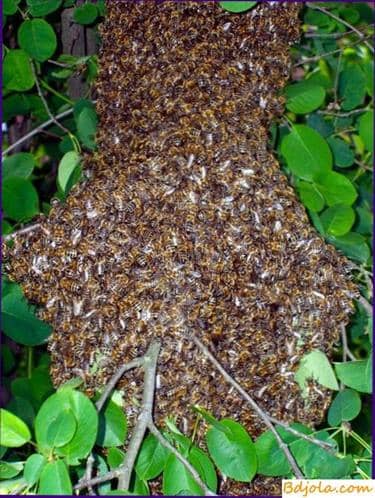So that the second swarm does not come out

The family from which the swarm came out is capable of forming another one or even two. After all, in the nest remained queen cells with growing larvae. The new uterus also strives to become the founders of families.
But not all swarms are profit. Follow swarms by weight less, especially late. With the first swarm it takes about half of the bees, but in the nest remains a large number of mature brood. Born bees quickly make up for the loss. Of these, the second and third swarms are formed.
The first swarm is usually the day after sealing the first mother liquor, about a week before the birth of a new uterus. And the second – on the ninth day after the first. All subsequent swarms, if the family does not finish digging, sometimes as large as a handful, can leave the mother’s nest almost every day. The family then is completely weakened and can no longer feed themselves.
Young small swarms are not able to store honey for their food, In natural conditions, they usually die. The same happens in apiaries. To save small families from starvation, you have to give them food. But in the winter they go weak, they do not tolerate it well. Therefore, such swarms of beekeepers do not leave, but unite with each other or strengthen them other families. “The first swarm – the hive system, the late swarm – to the old annex,” – say the beekeepers. And this is true. Only the first swarms should be considered good, full-fledged, viable families.
To prevent secondary swarming and strengthen the first swarm, use such a simple technique. The family that released the swarm is taken a little to the side, and a hive for the swarm is put in its place. The next day, after the swarm is planted in its new housing, but in the old place, all bees from the maternal family, who collect nectar and pollen, will come to him habitually. This trick (so called beekeepers
If the apiary is not planned to be increased, then, as soon as the honey gets stronger, the mother’s family is attached to the swarm. A powerful family honey-maker is being formed. At the meeting, one of the queens, the most powerful, will destroy the rival and lead the family.
For greater reliability after the release of the swarm in the mother’s family, you can remove the queen egg quarters, leaving one most mature, large, regular shape. In such queen cells there are the largest, well-developed and prolific females. The family will not swarm. True, some of the most rampant families, especially in small hives, quickly overflowing with bees, are stubbornly trying to let go of the second swarms. After the removal of the royal queen cells, they lay new on the larvae, which are found in ordinary bee cells.
After all, from the young bee larvae, the bees can remove the queens if they begin to feed them with royal jelly. The nest of the family again has to disassemble and break out these so-called fistula queen cells. Only then does the swarming cease. The family again begins to work vigorously, trying to make up for lost time.
But she does not succeed. A swarming family gathers little honey. After all, for a month, it almost did not work and did not replenish its fodder reserves. Having released swarms, having split their forces, it already becomes incapable, along with other families, to participate in honey collectors. It is no accident that they say: “Do not covet swarms and honey in one year.” Apiaries, which are allowed to swarm freedom, as a rule, are unproductive and unprofitable. In addition, swarming causes the beekeeper to always be near the bees, to follow the swarms, otherwise they will fly apart. This takes a lot of time.
It is unacceptable to dig at large apiaries, especially where the hives are placed in small groups far from each other, when it is impossible to follow the swarms. Therefore, beekeepers try or not allow swarming at all, or cause it artificially.
It is established that a close, overpopulated nest contributes to swarming. It is no coincidence that bees swarm more often in small-volume 12-frame hives than in spacious multi-hulls. Families with their own nests dig less. The rise in temperature in the nest also favors swarming. Hives therefore try to paint in white, put in a place protected from the sun. Such hives do not overheat.
Reliably distracts from swarming and good honey gathering. That is why uninterrupted replacement of blossoming honey-plants is important.
It is easier to prevent swarming in strong families than in medium-sized families. Families who have many bees, quickly learn new buildings or shops, while those who have not grown up do not go to extensions for a long time. In such families it is crowded and crowded, the breeding zone does not move apart. Swarming in these cases is almost inevitable.
So that the second swarm does not come out
